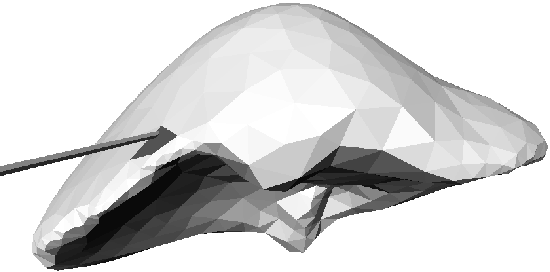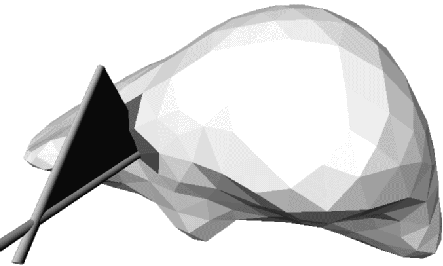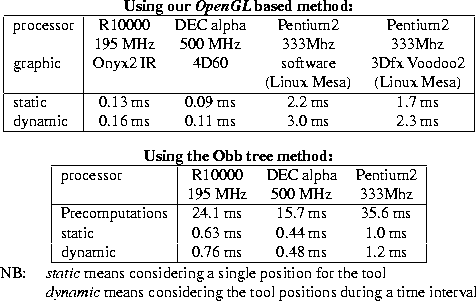


Next: Conclusion
Up: Real-time Collision Detection for
Previous: Taking the motion of
Results
Figure 9:
Collision detection between a triangular mesh modeling a human liver
and a static position of a tool (which is visualized as a segment).
 |
Figure 10:
Dynamic collision detection, where the tool motion
during a time interval is taken into account (this volume covered by the tool
is visualized as a single triangle).
 |
Figure 11:
Collision detection times
 |
Figure 12:
Acceleration factor provided by our method w.r.t. RAPID
 |
We have done a series of cross-tests to bench our collision methods:
- using our liver geometry (1224 triangles) or a simple tetrahedron
(4 triangles),
- testing either
static collisions with the tool at a time step (`static')
or collision with the volume covered by the tool during a time interval
(`dynamic'), as depicted in Figures 9 and 10,
- testing dynamic collision with different numbers of colliding faces
(between 5 and 25 for the liver, between 0 and 3 for the tetrahedron).
- comparing our method with the reference software package
RAPID2
implementing Obb trees [5],
- running on various hardwares and graphic accelerators.
Figure 11 sums up the comparisons of computational times
between our method and the RAPID software on various
platforms (each given time is a mean value between ten trials of
different collision configurations). Since the same compiler (gcc/egcs)
was used on all platforms for compatibility reasons, the results cannot
be used for a direct comparison between platforms (gcc uses to produce
inefficient code on SGI). The meaningful comparison is the ratio
between the two methods depending on the graphics and computational
performances of the
platform3.
The Obb tree method used in RAPID needs precomputing the
hierarchical data structure. In our application where the liver deforms
over time, RAPID's data-structure would have to be updated at
each time step. Since there is no method for doing so to the authors
knowledge,
we compared our method with the use of RAPID where pre-computations
are redone at each time step. Our method then brings an acceleration factor
from 150 on high-end hardwares to 12 with a software implementation of
OpenGL(however,Obb trees would probably give better results
if an efficient update algorithm taking advantage of temporal coherence
was developed). To be fair, we also computed the acceleration factor without
taking RAPID's pre-computation into account. Even in this case which is
only applicable to rigid objects, our method nearly brings an
acceleration factor of five for each
collision detection on high-end hardware. All these results are summarized in
Figure 12.



Next: Conclusion
Up: Real-time Collision Detection for
Previous: Taking the motion of
Jean-Christophe Lombardo
1999-05-17


